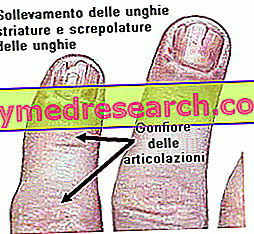Generality
Psoriatic arthritis is a disease characterized by chronic joint inflammation. As the name itself suggests, it is often associated with psoriasis; in particular, it affects about 30% of subjects suffering from this inflammatory skin disease.
Psoriatic arthritis can affect any joint in the body and typically occurs with limited symptoms, such as pain, swelling and joint stiffness.

Causes
The exact causes of psoriatic arthritis are not yet known, however some factors that may be involved in its pathogenesis have been identified. In particular, it is believed that the immune system of genetically predisposed subjects can attack the joints and other healthy tissues, determining the onset of an inflammatory process; this attack would be triggered, or at least favored, by particularly stressful events, such as some environmental factors (prolonged exposure to sunlight), trauma, surgery, infections, etc.
Psoriatic arthritis is typically associated with psoriasis and its familial predisposition. Recall that psoriasis is a chronic inflammatory disease of the skin, neither infectious nor contagious, characterized by an abnormal and often incomplete keratinization. At the level of the affected skin areas, red, delimited and raised patches arise, covered with silver or opalescent peeling (plaques). The most common sites involved in psoriasis are: elbows, knees, palm, sole of the foot, lumbar region, scalp and nails. In most cases, this skin disorder precedes the onset of psoriatic arthritis; the opposite situation is less frequent (onset of the joint condition at the same time as the psoriasis or before it).
Most patients experience psoriatic arthritis between the ages of 30 and 50, however the disease can occur at any age and is unusual in children. Men and women are equally affected, although the female sex is more likely to develop it, especially after pregnancy or menopause.
Signs and symptoms
To learn more: Psoriatic Arthritis Symptoms
Psoriatic arthritis can progress gradually, with mild symptoms, or rapidly, in severe form. Clinical signs can affect specific or different joints on the same or both sides of the body. Psoriatic arthritis generally affects one or more joints of the hands and feet and occurs mainly at the distal level (ie at the ends of the fingers, near the nail). However, it can also affect the wrists, elbows, knees, ankles and spine.
Generally, in the case of psoriatic arthritis, at least one of the following symptoms appears:
- Generalized fatigue;
- Pain, swelling and stiffness (especially in the morning) in one or more joints; sometimes, these symptoms are associated with heat and redness;
- Homogeneous swelling of a finger or toe due to inflammation of tendons and joints (dactilitis);
- Pain in and around the feet and ankles, especially tendinitis in the Achilles tendon or plantar fasciitis in the sole of the foot;
- Nail alterations (psoriatic onychopathy): separation of the nail from the nail bed, streaks and cracks or loss of the nail itself (onycholysis);
- Pain in the sacrum area (lower back, above the coccyx);
- Movement reduction;
- Headache and jaw pain;
- Talalgie (pain in the heels) and Achilles tendinitis;
- Bursitis (inflammation of serous bursae);
- Enthesite (inflammation of the bone insertion point of the tendons);
- Eye involvement (example: conjunctivitis, with redness and itching of the eyes).
The impact of psoriatic arthritis on quality of life depends on the joints involved and the severity of the symptoms. Both in psoriasis and in the joint condition, phases of active disease can alternate with periods of remission. Persistent inflammation can cause damage to the joints involved and, in the most severe forms, can develop into a debilitating disease.
Early diagnosis and available treatments are important to avoid or slow down the effects of the pathological condition.
Classification
Depending on the joints involved, it is possible to distinguish five different types of psoriatic arthritis:
- Asymmetric oligoarthritis : affects about 70% of patients; in general, it is mild and involves less than three large and small joints.
- Rheumatoid-like arthritis (symmetrical polyarthritis) : it represents about 25% of cases and is crippling in about 50% of cases; it strikes symmetrically the joints of the body, with an inflammation that simulates rheumatoid arthritis.
- Mutilating arthritis: it is an aggressive and deforming arthritis, characterized by osteolysis (destruction of bone structures). This rare condition can progress over months or years, causing severe joint damage.
- Ankylosing spondylitis : it is characterized by pain and stiffness in the spine or neck, but it can also affect hands and feet, similar to symmetrical arthritis.
- Predominantly involved in the distal interphalangeal joints : it is present in about 5% of patients and is characterized by inflammation and stiffness of small joints near the extremities of hands and feet (rarely involved in other arthritis).
Diagnosis
The diagnosis is formulated mainly on a clinical basis, but the prior exclusion of other similar conditions is advisable.
A rheumatologist can precisely define the patient's clinical picture, using medical history, physical examinations, blood tests and imaging techniques (magnetic resonance and radiographs). Blood chemistry tests can be performed to rule out other types of arthritis that show similar signs and symptoms, including gout, osteoarthritis and rheumatoid arthritis. In patients with psoriatic arthritis, blood tests may reveal mild anemia (decreased hemoglobin and red blood cells). Occasionally, skin biopsies (small skin samples removed for analysis) may be necessary to confirm the presence of psoriasis.
Factors that help confirm the diagnosis of psoriatic arthritis include:
- Full-blown psoriasis (often, the skin disease precedes psoriatic arthritis);
- Positive family history for psoriasis or psoriatic arthritis (especially if the patient has a family member close to one of the conditions);
- Negative result for rheumatoid factor and anti-CCP (which are high in other forms of arthritis);
- Positive outcome for high sedimentation rate (indicates the presence of an inflammatory process) and C-reactive protein (highlights the presence of acute inflammation);
- Involvement of distal interphalangeal joints (symptom NOT characteristic of rheumatoid arthritis);
- Typical changes of skin and nails, characteristic of psoriasis and psoriatic arthritis (psoriatic onychopathy).
Some characteristic manifestations make it possible to distinguish psoriatic arthritis from other arthropathies; these distinctive signs include the dactylitis (the so-called "sausage-shaped finger") and the esentite, an inflammation of the bone insertion point of tendons and ligaments. This latter condition occurs more frequently in the Achilles tendon (in the back of the heel) or in the plantar fascia (in the lower part of the feet). Tendonitis (inflammation of tendons) and bursitis (inflammation of serous bursae) can also be distinctive signs.
Magnetic resonance imaging and symptomatic joint ultrasound may be useful for detecting signs of inflammation in different joint structures in detail. Conventional radiography is generally not useful for diagnosis in the early stages of the disease, but shows characteristic changes after months or years after the onset of symptoms.
Treatment
Psoriatic arthritis treatment helps relieve pain, reduce swelling, protect joint function, maintain mobility and prevent further damage.
Medical therapy depends on the type of psoriatic arthritis in place, its severity and reaction to treatment. Milder cases of joint pain can be managed with NSAIDs alone, but there is a tendency to use disease-modifying antirheumatic drugs (DMARDs) or biological response modifiers (MRDs), which are useful for preventing irreversible joint degeneration. Good psoriasis control can be useful in the treatment of psoriatic arthritis: some therapeutic protocols are approved for the simultaneous management of both conditions.
Non-steroidal anti-inflammatory drugs (NSAIDs)
Psoriatic arthritis is a chronic inflammatory disease, so treatments are aimed at reducing and controlling joint inflammation. In general, the first therapeutic approach involves the prescription of NSAIDs, such as ibuprofen and naproxen, followed by more powerful non-steroidal anti-inflammatory drugs, such as diclofenac, indomethacin and etodolac. Long-term use of NSAIDs can lead to stomach and bowel disorders. Other potential adverse effects include damage to the kidneys and the cardiovascular system.
Disease-modifying antirheumatic drugs (DMARD)
If arthritis is severe and does not respond to NSAIDs, disease-modifying anti-rheumatic drugs (DMARDs) may be prescribed.
DMARDs help slow the progression of psoriatic arthritis. Rather than reducing pain and inflammation, this class of drugs helps limit the extent of damage to bones, tendons, ligaments and cartilages.
Most DMARDs work slowly and can take weeks or up to 4-6 months to produce a full effect. To treat psoriatic arthritis, methotrexate or leflunomide are commonly prescribed; cyclosporine, azathioprine and sulfasalazine can be considered as an alternative.
Sometimes, you may need to take a combination of these medicines. These immunosuppressive drugs can also reduce the skin symptoms of psoriasis, but are burdened by possible side effects in the kidneys, liver and the immune system (they can increase the risk of infections).
Biological response modifiers (MRB)
Recently, using recombinant DNA technology, a new class of drugs has been developed, called biological response modifiers (MRB).
The biological response modifiers prescribed for psoriatic arthritis are TNF-α inhibitors - including infliximab, golimumab, etanercept and adalimumab, ustekinumab - given by intravenous injection.
These drugs act on specific targets, with a different mechanism of action than traditional DMARDs, which instead impact the entire immune system. This drug treatment can be indicated if:
- Psoriatic arthritis did not respond to at least two different types of DMARDs;
- The patient cannot be treated with at least two different types of DMARDs;
Side effects include skin reactions at the injection site, increased susceptibility to infection, nausea, fever, headache and, more rarely, nervous system disorders, blood diseases or certain types of cancer.
For further information: Drugs for the treatment of psoriatic arthritis »
Other treatments
In some cases, the doctor may proceed with a corticosteroid injection to help temporarily reduce inflammation in a joint. Surgery is not used as the main treatment for psoriatic arthritis, but it can be useful to repair or replace severely damaged joints. In patients who have had the condition for a long time or have particularly severe joint damage, surgery can correct malformations and joint destruction by replacing the affected joint with an artificial prosthesis.
Many people with arthritis develop stiff joints and muscle weakness due to lack of use. Physical activity helps keep joints flexible and improves overall health. Maintaining a healthy weight and managing associated conditions (eg, hypertension) are equally important aspects of psoriatic arthritis treatment. A walking aid, supports and orthotics can help protect the joints and avoid excessive stress on feet, ankles or knees, affected by psoriatic arthritis.
| " | 1 | 2 | 3 | 4 | 5 | 6 | » |



